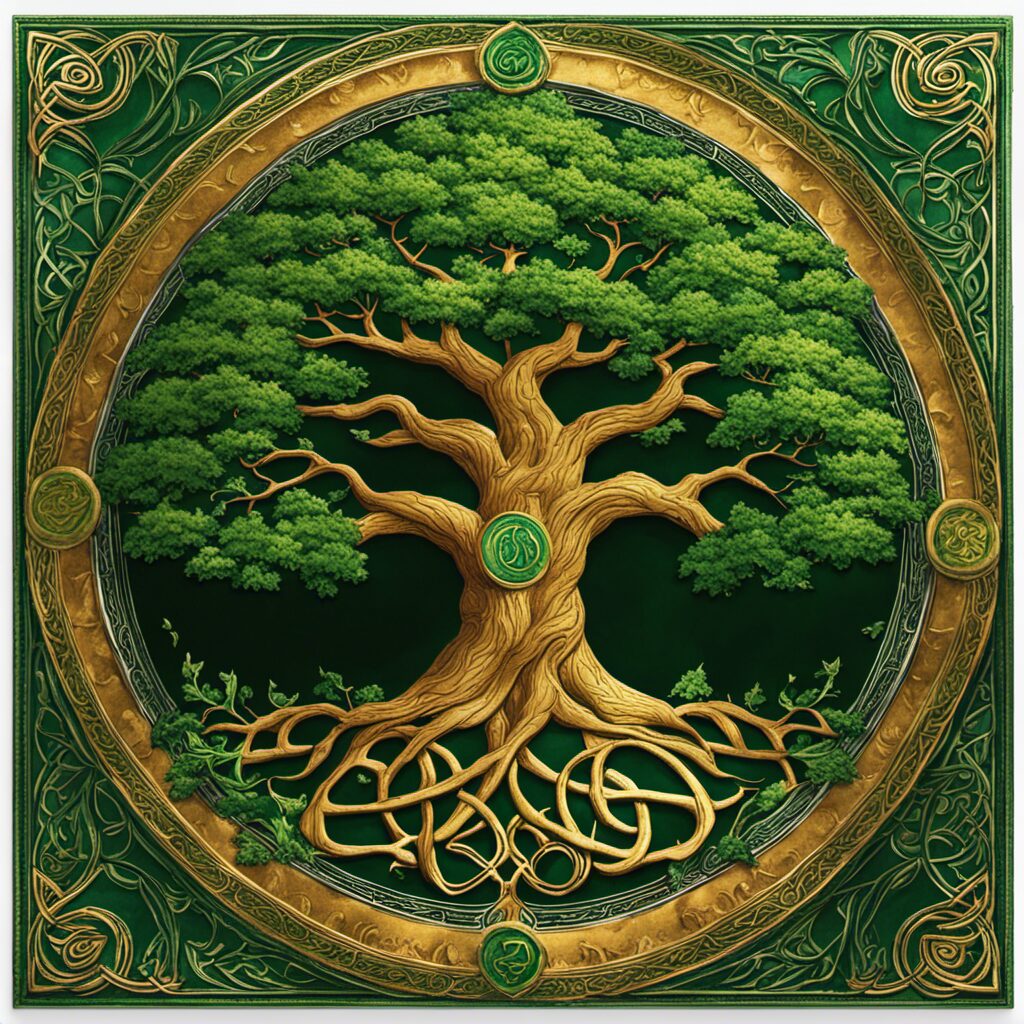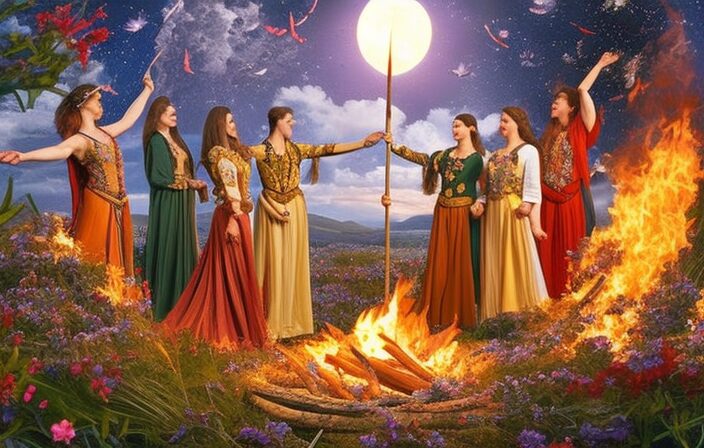The present article examines the Celtic Moon Calendar, an ancient lunar calendar consisting of 13 months. It delves into the origins of this calendar and elucidates the significance of the moon in Celtic culture.
Furthermore, it explores the structure and nomenclature of the 13 month lunar calendar, along with its association with astrology. The article also discusses how this calendar honors various moon goddesses and celebrates the new moon and full moon in Celtic tradition.
Lastly, it provides insights on incorporating the Celtic Moon Calendar into daily life.
Key Takeaways
- The Celtic Moon Calendar originated from ancient Celtic cultures and relied on a 13 month lunar calendar system, playing a significant role in cultural practices and beliefs.
- The lunar cycle consists of eight distinct phases which have implications in astronomy, astrology, agricultural practices, and spiritual rituals.
- The 13 Month Lunar Calendar allowed for the alignment of agricultural and religious activities with lunar events, influencing plant growth, soil fertility, and crop harvests.
- Naming celestial bodies, including the moon, held symbolic and spiritual meanings in ancient civilizations and reflected cultural practices and beliefs, providing a sense of order and connection to the environment and cosmic forces.
Origins of the Celtic Moon Calendar
The origins of the Celtic Moon Calendar can be traced back to ancient Celtic cultures, where they relied on a 13 month lunar calendar system for tracking time. This calendar was closely tied to the cycles of the moon and played a significant role in the cultural practices and beliefs of the Celts.
The Celtic people had a deep reverence for nature and believed that all aspects of life were interconnected. They observed the movement of celestial bodies, particularly the moon, as a way to understand and navigate their environment. The lunar cycles provided them with valuable insights into agricultural patterns, hunting seasons, and rituals associated with fertility and harvest.
The cultural significance of the Celtic Moon Calendar extended beyond practical timekeeping. It was deeply intertwined with religious ceremonies, marking important dates such as solstices, equinoxes, and other celestial events. These rituals were essential in maintaining harmony between humans and nature while ensuring prosperity for their communities.
Moreover, the history of this calendar reflects a rich tapestry of Celtic traditions passed down through generations. By observing the phases of the moon, these ancient cultures developed an intricate understanding of time that shaped their daily lives and spiritual practices.
Understanding the Lunar Cycle
Understanding the progression of phases in the lunar cycle provides valuable insights into the celestial movements. The lunar cycle refers to the continuous changes in appearance of the Moon as it orbits around the Earth. It is divided into eight distinct phases, each representing a different position of the Moon relative to the Sun and Earth. These phases include new moon, waxing crescent, first quarter, waxing gibbous, full moon, waning gibbous, third quarter, and waning crescent.
During each phase, different portions of the Moon are illuminated by sunlight and visible from Earth. This understanding of lunar phases has significant implications in various fields including astronomy and astrology. In astronomy, studying these phases helps astronomers track celestial events such as eclipses and understand how light interacts with celestial bodies. Additionally, understanding lunar symbolism in astrology allows astrologers to interpret how these phases influence human behavior and personality traits.
The study of lunar cycles also plays a crucial role in cultural practices across different societies. For example, many ancient civilizations used lunar calendars for agricultural purposes as they believed that certain crops should be planted or harvested during specific phases to optimize growth or yield.
The Importance of the Moon in Celtic Culture
An examination of Celtic cultural practices reveals the significant role played by lunar phases in guiding agricultural activities and religious ceremonies. The origins of lunar worship can be traced back to ancient times when the Celts relied heavily on agriculture for their sustenance. They observed that the moon’s cycles had a direct impact on plant growth and harvest yields, leading them to develop a deep reverence for this celestial body.
In Celtic mythology, the moon was associated with various deities and held great spiritual significance. One such deity was Cerridwen, the goddess of fertility and rebirth, who was believed to govern the lunar cycle. The moon was also closely linked to other important Celtic gods such as Lugh and Manannán mac Lir.
The Celtic calendar itself was based on a 13-month lunar cycle, with each month corresponding to a different phase of the moon. This allowed the Celts to align their agricultural activities with specific lunar events, such as planting during the waxing moon and harvesting during the full moon. Additionally, religious ceremonies and rituals were often timed according to lunar phases, further emphasizing its importance in Celtic culture.
Overall, the moon held a central role in Celtic society, influencing not only their agricultural practices but also their spiritual beliefs and rituals. Its connection to fertility and rebirth made it a symbol of life’s cyclical nature, reflecting the deep-rooted connection between humans and nature in Celtic culture.
Exploring the 13 Month Lunar Calendar
Exploring the 13-month cycle of the moon allowed the Celts to align their agricultural and religious activities with specific lunar events. The Celtic calendar was based on a 13 month lunar cycle, where each month corresponded to one complete lunar phase. This calendar system enabled them to track the changing energies of the moon throughout the year, allowing for more precise planning and decision-making in various aspects of their lives.
The lunar phases played a crucial role in guiding the Celts’ agricultural practices. They recognized that different phases of the moon influenced plant growth, soil fertility, and crop harvests. By closely observing these lunar patterns, they could determine when to plant seeds or crops, when to harvest them, and even when certain plants were at their most potent medicinal state.
In addition to its significance in agriculture, the 13-month lunar calendar also had profound religious implications for the Celts. Each month was associated with a particular deity or aspect of nature, which guided their rituals and ceremonies. The alignment of these religious practices with specific lunar events allowed them to tap into the unique energies present during each phase.
Overall, by exploring and understanding this intricately designed 13-month lunar calendar system, the Celts were able to harmonize their agricultural and religious activities with natural rhythms and energies provided by different phases of the moon.
The Names of the Celtic Moon Months
The names of the Celtic moon months carry significant meaning and historical importance. Each month’s name is derived from various cultural and natural references, reflecting the beliefs and practices of the ancient Celtic people.
Understanding the significance behind these names provides valuable insights into their worldview, religious customs, and agricultural practices.
Studying the historical context in which these names originated helps us appreciate the rich cultural heritage associated with each lunar month.
Meaning Behind Moon Names
Moon names in the Celtic moon calendar hold significant meanings that reflect various aspects of nature and human life. The symbolism behind these names is deeply rooted in the lunar cycle effects.
Each moon name represents a specific phase or attribute of the moon, providing insight into its influence on different aspects of existence. For example, the Wolf Moon signifies strength and survival instincts, as it was believed to be a time when wolves roamed freely, while the Harvest Moon is associated with abundance and gratitude, marking the time for reaping what has been sown.
These symbolic connections between moon names and natural phenomena serve as a guide for understanding the cyclical patterns of nature and their impact on human experiences. By acknowledging these meanings, individuals can attune themselves to the rhythms of life and harness the energy each moon offers.
Historical Significance of Names
From an anthropological perspective, the historical significance of naming celestial bodies has been a common practice among various cultures throughout human history. The act of naming celestial bodies holds great importance as it reflects the cultural practices and beliefs of different societies.
-
Historical origins:
-
Naming celestial bodies can be traced back to ancient civilizations such as the Babylonians and Egyptians, who believed that these names held both symbolic and spiritual meanings.
-
In some cases, the names given to celestial bodies were associated with gods or goddesses from mythology.
-
Cultural practices:
-
Naming celestial bodies served practical purposes for early navigators, allowing them to track time and navigate vast oceans.
-
Different cultures developed their own unique systems for naming celestial bodies based on their understanding of astronomy and cosmology.
-
Significance in society:
-
The act of naming celestial bodies not only provided a sense of order and structure but also helped shape cultural identities by connecting people to their environment and cosmic forces.
Rituals and Festivals of the Celtic Moon Calendar
A comprehensive analysis of the rituals and festivals associated with the Celtic Moon Calendar reveals a rich tapestry of cultural practices deeply rooted in ancient beliefs and traditions. The historical origins of these practices can be traced back to the ancient Celts, who had a deep reverence for nature and its cycles. The Celtic Moon Calendar is based on a 13-month lunar cycle, with each month representing a specific moon phase. Each month was marked by unique rituals and festivals that were celebrated by the Celtic people.
One such festival is Imbolc, which falls on February 1st or 2nd and marks the beginning of spring. It was a time for purification and cleansing, with fires being lit to symbolize new beginnings.
Another significant festival is Beltane, celebrated on May 1st. This festival honored fertility and growth, with bonfires being lit to ward off evil spirits and ensure abundant crops.
Lughnasadh, celebrated on August 1st, marked the beginning of the harvest season. It was a time for feasting, games, and competitions to honor Lugh, the god of light.
Finally, Samhain was celebrated on October 31st as the Celtic New Year. It was believed that during this time, spirits could cross over into the physical world, so bonfires were lit to ward off unwanted entities.
These rituals and festivals not only connected the Celtic people to their ancestral roots but also served as important markers in their agricultural calendar. They provided an opportunity for communal gatherings, storytelling, music, dance, and other forms of cultural expression that reinforced social cohesion within their communities.
How to Sync Your Life With the Lunar Calendar
The process of aligning personal activities and routines with the phases of the moon requires careful observation and consideration of the lunar cycle. Syncing one’s life with the lunar calendar can have various benefits, including increased mindfulness and connection to nature.
To successfully sync routines with moon phases, individuals can follow these steps:
-
Observe Moon Phases: Regularly check the lunar calendar or use smartphone apps to keep track of moon phases. This will help identify when specific moon phases begin and end.
-
Understand Lunar Energies: Familiarize oneself with each moon phase’s characteristics and associated energies. For example, the New Moon is a time for new beginnings and setting intentions, while the Full Moon represents culmination and release.
-
Plan Activities Accordingly: Adjust daily activities based on the energy of each moon phase. For instance, during the Waxing Moon (when it is growing in illumination), focus on projects that require growth and development.
By syncing routines with moon phases, individuals can optimize their efforts by utilizing different energies at different times. However, it is essential to remember that personal intuition should also be taken into account when planning activities around lunar cycles.
The Spiritual Significance of Each Moon Month
This discussion will explore the spiritual significance of each month in relation to lunar cycles. Understanding the connection between lunar phases and spirituality can provide insights into various aspects of life, including personal growth, emotional well-being, and cosmic energy.
Lunar Cycles and Spirituality
Lunar cycles have long been regarded as significant in various spiritual practices. The connection between lunar phases and emotional well-being is a topic of interest for many individuals seeking to enhance their spiritual journey.
Moon rituals, which often align with specific lunar phases, are commonly used as a means of harnessing the energy of the moon to manifest desires and intentions. These rituals can include activities such as meditation, journaling, or creating altars adorned with symbolic objects.
Additionally, manifestation techniques involving the moon often involve setting clear intentions during specific lunar phases and utilizing visualization exercises to manifest these desires into reality.
Exploring the relationship between lunar cycles and spirituality provides individuals with an opportunity for self-reflection and personal growth on their spiritual path.
Meaning Behind Each Month
The Celtic lunar calendar is deeply intertwined with moon symbolism and the celebration of the lunar cycle through various festivals. Each month in this calendar holds its own unique meaning and significance. The ancient Celts believed that these months were not just arbitrary divisions of time, but rather representations of different aspects of nature and life.
For instance, the first month, known as Samhain, marked the beginning of winter and was associated with death and rebirth. Imbolc, which fell in February, represented the awakening of spring and was linked to fertility and purification rituals. Beltane, celebrated in May, symbolized the height of summer and was a time for love and abundance.
These monthly themes were reflected in the Celtic lunar festivals held during each corresponding month. These festivals served as important communal gatherings where people honored nature’s cycles while also seeking guidance from divine forces.
Aligning With Nature’s Rhythms in the Celtic Calendar
Aligned with the cycles of nature, the Celtic calendar offers a way to harmonize human activities with natural rhythms. The Celtic moon calendar rituals have long been used by ancient Celts to mark and celebrate important events and transitions in their lives. By aligning with natural rhythms, these rituals allowed them to connect deeply with the earth, seasons, and lunar cycles.
To engage the audience further, here are three key aspects of aligning with nature’s rhythms in the Celtic calendar:
-
Lunar Phases: The Celtic moon calendar is based on the lunar phases, which were intimately connected to agricultural practices. Each month was named after a specific tree or plant that held significance during that time. Aligning activities such as planting, harvesting, and hunting with these lunar phases ensured optimal results.
-
Seasonal Festivals: In addition to honoring lunar cycles, the Celtic calendar also included seasonal festivals known as ‘fire festivals.’ These celebrations marked important points in the agricultural year such as Beltane (May 1st) and Samhain (October 31st). By participating in these festivals, individuals sought to maintain a harmonious relationship with nature.
-
Spiritual Connection: The Celtic moon calendar rituals were not just about practical considerations but also held profound spiritual meaning for the Celts. By observing certain rituals during specific times of the year, they believed they could tap into spiritual energy and receive guidance from higher powers.
The Celtic Moon Calendar and Astrology
Astrological influences were considered important factors in the Celtic system of timekeeping, as they guided the timing of rituals and activities. The Celts believed that the movement and alignment of celestial bodies had a profound impact on human lives and personal growth. They observed the lunar phases closely and developed a lunar calendar that harmonized with these astrological patterns.
The Celtic moon calendar consisted of 13 months, each corresponding to a specific lunar cycle. These lunar phases were believed to influence various aspects of life, including fertility, healing, and spiritual development. By aligning their rituals and activities with the appropriate lunar phase, the Celts sought to harness the cosmic energies for personal growth.
Astrology played a crucial role in determining which activities were most auspicious during different lunar phases. For example, during the waxing phase when the moon was growing brighter, it was considered an optimal time for initiating new projects or setting intentions. Conversely, during the waning phase when the moon was decreasing in brightness, it was seen as a favorable period for reflection, release, and letting go.
Honoring the Moon Goddesses in the Lunar Calendar
This discussion will explore the Lunar Goddess Symbolism, Rituals and Ceremonies, Cultural Significance, and History.
The symbol of the lunar goddess holds deep meaning in various cultures around the world. These symbols represent femininity, intuition, and cycles of life.
Rituals and ceremonies dedicated to lunar goddesses have been performed for centuries as a way to honor their power and influence. These rituals often involve offerings, prayers, and dances that align with the lunar cycle.
Additionally, the cultural significance of lunar goddesses can be seen in mythology, folklore, and religious practices across different societies throughout history. Understanding the history behind these traditions provides valuable insights into human beliefs and spirituality related to the moon’s divine feminine energy.
Lunar Goddess Symbolism
Symbolism associated with the lunar goddess is an important aspect of the Celtic moon calendar, highlighting various cultural interpretations and representations. The worship of lunar goddesses in ancient Celtic societies was deeply rooted in their religious beliefs and practices. The Celtic people revered the moon as a powerful deity, embodying feminine qualities such as fertility, intuition, and mystery. This reverence for lunar goddesses resulted in a rich symbolism surrounding them within the context of the moon calendar.
-
Lunar Goddess Worship:
-
Rituals honoring lunar deities
-
Offerings made to appease and seek blessings from these goddesses
-
Temples dedicated to lunar worship
-
Lunar Deity Symbolism:
-
Moon phases representing different aspects of the goddess
-
Associations with natural elements like water or plants
-
Depictions in art and mythology showcasing specific attributes or roles
This symbolism allowed the Celts to connect with their spiritual beliefs while navigating their lives according to the cycles of the moon.
Rituals and Ceremonies
Rituals and ceremonies played a significant role in the worship of lunar goddesses, providing a means for ancient societies to connect with their spiritual beliefs and seek blessings from these deities.
In the context of the Celtic moon calendar, these rituals were intricately linked to the power of moon phases and the desire to connect with the natural world. The Celtic people valued the cyclical nature of the moon, viewing it as a symbol of fertility, growth, and transformation.
To honor this connection, they performed ceremonies during specific lunar phases, such as full moons or new moons. These rituals often involved offerings, prayers, chants, and dances dedicated to lunar goddesses. By engaging in these practices, individuals sought to harmonize their lives with cosmic forces and tap into the mystical energies associated with lunar cycles.
Such rituals served as a way to reinforce one’s connection with both divine powers and the natural world itself.
Cultural Significance and History
The cultural significance and historical importance of lunar worship can be observed through the extensive documentation of rituals and ceremonies dedicated to lunar goddesses in ancient societies. The Celtic moon calendar, with its 13-month lunar cycle, had a profound impact on agriculture and the cultural customs surrounding lunar phases.
-
Agriculture: The Celtic people closely monitored the moon’s phases to determine optimal planting and harvesting times. They believed that aligning their agricultural activities with the lunar cycle would enhance crop growth and yield.
-
Festivals: The different phases of the moon were celebrated through various festivals and rituals. These events often involved offerings to honor lunar deities, such as Arianrhod or Cerridwen, who were associated with fertility, abundance, and protection.
-
Divination: Lunar worship also encompassed divination practices where individuals sought guidance or predictions by observing the moon’s behavior or using specific rituals during particular lunar phases.
The Celtic moon calendar played a central role in shaping agricultural practices and fostering a deep connection between ancient Celts and the celestial world. This emphasis on lunar worship demonstrates how cultures throughout history have recognized the profound influence of the moon on human life.
Celebrating the New Moon and Full Moon in Celtic Tradition
Observances of the New Moon and Full Moon in Celtic tradition involve specific customs and practices. These rituals are deeply rooted in the ancient Celtic moon calendar traditions, which held great significance in the lives of the Celts. The Celtic moon calendar, also known as the Coligny calendar, is a 13-month lunar calendar that closely aligns with the cycles of the moon. Each month of this calendar begins with either a New Moon or a Full Moon.
During the New Moon, when the moon is not visible in the sky, it is believed to be a time of introspection and new beginnings. This phase often marks the start of new projects or intentions for many Celts. Rituals during this time may involve setting intentions, meditating, or engaging in divination practices to gain insight into future endeavors.
On the other hand, during the Full Moon, when the moon is at its brightest and fullest appearance in the night sky, it symbolizes completion and abundance. It is considered an auspicious time for celebration and manifestation. Many Celtic communities would come together to honor this phase by holding feasts, performing dances and music, and participating in communal ceremonies.
Overall, these observances reflect how closely intertwined Celtic culture was with nature’s rhythms and cycles. The rituals associated with both New Moon and Full Moon provide opportunities for connection with oneself, others within their community, and ultimately with nature itself through honoring these lunar phases according to their traditional customs.
Incorporating the Celtic Moon Calendar Into Your Daily Life
Incorporating the cycles of celestial bodies into daily routines allows individuals to align their activities with natural rhythms and potentially enhance their connection with nature. One way to do this is by incorporating the phases of the moon into daily life. The moon has long been regarded as a powerful symbol in many cultures, including the Celtic tradition. By following the Celtic Moon Calendar, individuals can synchronize their actions with the different lunar phases and harness the energy associated with each phase.
Here are three ways to incorporate moon phases into daily life:
-
Tracking Moon Phases: Keep track of the moon’s phases using a lunar calendar or smartphone app. This will help you become more aware of how the moon influences your mood, energy levels, and overall well-being.
-
Rituals and Intentions: Plan rituals or set intentions during specific moon phases. For example, during a new moon, you can focus on setting goals or starting new projects, while during a full moon, you can practice gratitude and release any negative energies.
-
Lunar Gardening: Align your gardening activities with specific moon phases for optimal plant growth and health. Planting seeds during a waxing (growing) moon and pruning during a waning (shrinking) moon are common practices in lunar gardening.
Conclusion
The Celtic Moon Calendar, with its 13 month lunar cycle, holds a rich history and significance in Celtic culture.
This ancient calendar is deeply rooted in the understanding of the moon’s influence on daily life.
Each month is named after different aspects of nature and reflects the interconnectedness between humans and their environment.
By incorporating this calendar into our daily lives, we can honor the moon goddesses and celebrate the cycles of new and full moons.
Let us embrace this celestial guide to deepen our connection with nature and find harmony within ourselves.




